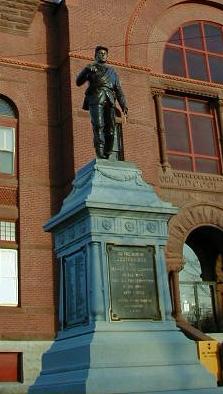
Photo courtesy of Dick Whitney’s History Site
This is the third is a series of essays on the role of the Town of Southbridge in the Civil War. As the war continued the amount of involvement of the local legislative bodies diminished as the Federal Government took over control of the armed forces. The interesting part of the story is that as the war continued the bounty continued to increase for men who would enlist. Each town was given a quota to fill of men who would enlist for specified periods of time. As one did not necessarily have to be from a particular town to enlist from that town, there is evidence that men “shopped around” a little to find the best deal. I do not say this to diminish their service, but only to show to the extremes that men would take to make sure their families were secure when they went off to war.
In the end, Southbridge furnished 400 men for the war which was a surplus of 19 over the quota set by the Commonwealth. The names of those 400 are enshrined for eternity on the monument that sits on the lawn in front of the Southbridge Town Hall on Elm Street. The picture that accompanies this essay is of that monument.
These are the actions that the Board of Selectman took during 1863-64:
January 5, 1863, the treasurer was authorized to borrow twenty-five hundred dollars for the payment of bounties to volunteers to fill the quota of the town under the recent call of the President for more men, and the expenses of recruiting the same.
September 21, 1863, Voted to pay State aid to the families of men who are or may be drafted in the town, the same as paid to the families of volunteers.
November 3, 1863, The treasurer was authorized to borrow money to pay State aid to the families of men who have died or become disabled in the military service.
April 4, 1864, Three thousand dollars were appropriated for recruiting purposes, and twelve hundred dollars for the payment of money advanced by individuals of their own means to aid recruiting during the past years.
June 20, 1864, The bounty to volunteers for three years’ service was fixed at one hundred and twenty-five dollars. The selectman were authorized “to set apart a suitable plot of ground in the public cemetery for the erection of a monument to the soldiers of Southbridge who have died or may hereafter die in the service of their country during this war.”
Note: The Grand Army of the Republic plot is located in center of the Town Cemetery under a flag pole. As far as I can tell there are only 2 people buried in this plot, each has their own stone, but no monument is located there to the remembrance of those who died and are buried in other places.
Southbridge in the Civil War 1861
Southbridge in the Civil War 1862
Southbridge and the Battle of Gettysburg
